Aronuitia te reo
Insights from the National Monitoring Study of Student Achievement
Esther Smaill and Teresa Maguire
Introduction
Nō Kōtirana, nō Ingarani hoki ōku tīpuna. He Tangata Tiriti ahau. He kairangahau matua au i Rangahau Mātauranga o Aotearoa. Ko Esther Smaill tōku ingoa. Over two decades ago, as I sat in a Māori 101 lecture at the University of Auckland learning how to say simple phrases like “I haere au ki te toa” and “E oma ana te tamaiti”, it struck me as absurd that I hadn’t been taught these things at school. Quite a lot has changed since then. I’ve become a competent speaker and lifelong learner of te reo Māori. Likewise, I now have a much clearer understanding of the role that the education system played in deterring the use of te reo Māori and disrupting intergenerational transmission within whānau Māori. Today, my three children—who, like me, are Pākehā—are learning much more reo Māori at school than most tamariki of my generation ever did. And yet there is still much work to be done.
Nō Ingarangi, nō Airani hoki ōku tīpuna. He Tangata Tiriti ahau. He kaiwhakawhanake rauemi, he kairangahau hoki au i Rangahau Mātauranga o Aotearoa. Ko Teresa Maguire tōku ingoa. Like Esther, I am a Pākehā learner of te reo Māori and a former primary school teacher. And, like Esther, I work at the New Zealand Council for Educational Research (NZCER) and contribute to the National Monitoring Study of Student Achievement (NMSSA). Together we share the belief that our education system still has much to do to ensure that, first and foremost, all tamariki Māori are enabled to learn their own language and, beyond that, that each and every one of us is able to speak the indigenous language of this country.
Teachers and principals in English-medium primary schools overwhelmingly agree about the importance of providing their students with opportunities to learn te reo Māori (NMSSA, 2016a). But there are clear indications that many teachers and principals need help identifying how best to undertake this important mahi (Bright et al., 2021; Education Review Office, 2020; Murphy et al., 2019). So, when the two of us were offered the chance to develop Aronuitia te reo, a resource intended to assist English-medium schools with strengthening their provision of reo Māori learning opportunities, we jumped at it.
What is Aronuitia te reo?
Developed for NMSSA, Aronuitia te reo is a deck of cards designed to prompt professional conversations about improving the teaching and learning of te reo Māori. It is intended to assist teachers and/or schools who are early in their reo Māori learning journeys. Aronuitia te reo was developed with the support of, and advice from, Te Wāhanga, the Māori research team at NZCER. This strengths-based resource is based on findings from the 2016 National Monitoring Study of Student Achievement (NMSSA). Aronuitia te reo contains three sets of activity cards, each with a different focus.
•Whakamahia uses QR codes to provide easy access to reo Māori resources.
•Whakaarohia is designed to stimulate discussion about the importance of providing students with opportunities to learn te reo Māori.
•Whakarauorahia provides schools with the opportunity to think about how they can contribute to the revitalisation of te reo Māori.
Since its launch, Aronuitia te reo has received overwhelmingly positive reviews from teachers and principals.1 In this Assessment News article, we introduce Aronuitia te reo, tell you a little bit about how it was developed from the 2016 NMSSA findings, and provide some examples of how you could use it with your colleagues.
How Aronuitia te reo flows out of the NMSSA
New Zealand’s NMSSA provides an annual snapshot of student achievement at Year 4 and Year 8 in English-medium state schools.2 Over the course of its 5-year cycle, the NMSSA assesses all the learning areas that are specified in The New Zealand Curriculum (Ministry of Education, 2007).
In 2016, Learning Languages was one of two learning areas that were assessed. The NMSSA’s assessment programme was designed to accommodate both the range of international languages that are included in schools’ programmes and the official languages of Aotearoa New Zealand: te reo Māori and New Zealand Sign Language (NZSL). The Aronuitia te reo resource builds from the information that the NMSSA study gathered about Māori language learning. The NMSSA questionnaires for students, teachers, and principals, included questions about:
•student attitudes towards, and experiences of, learning te reo Māori
•teacher and principal views about reo Māori instruction in their school
•teacher confidence as a reo Māori educator
•reo Māori professional learning opportunities
•schools’ provision for the teaching of te reo Māori.
The NMSSA study also included a focus on achievement in te reo Māori. To support this, a Te Reo Māori (TRM) assessment was developed and used to gauge students’ knowledge and understanding of reo Māori words and phrases (see Text Box 1).
The TRM assessment, which was completed by all students, was guided by Te aho arataki marau mō te ako i te reo Māori—kura auraki: Curriculum guidelines for teaching and learning te reo Māori in English-medium Schools—Years 1–13 (Ministry of Education, 2009). The assessment mainly focused on Level 1 of these guidelines.
Designed to assess students’ knowledge and understanding of a selection of reo Māori words and phrases, the TRM assessment included a mix of selected-response and short constructed-response items. Students answered the selected-response questions on a computer while the open-ended questions were completed by hand. As can be seen in Figure 1 below, the computer-based items included an audio option, which enabled students to hear, as well as read, the question being asked.
Text box 1. Examples of selected-response items from the TRM assessment
The findings from this NMSSA study were presented in the Learning Languages 2016—Key Findings report (NMSSA, 2016a) and in a summary document that was developed for teachers and principals and distributed in the Education Gazette (NMSSA, 2016b). After the 2020 NMSSA study was cancelled because of COVID-19, a decision was made to produce an additional resource for teachers based on the 2016 reo Māori findings. Rather than writing our usual Insights report,3 we decided to produce a card-based resource. The result is Aronuitia te reo with its three sets, Whakamahia, Whakaarohia, and Whakarauorahia.
As noted above, the purpose of Aronuitia te reo is to promote professional conversations about improving the teaching and learning of te reo Māori. The cards could be used in staff or syndicate meetings (for instance, as part of professional learning or inquiry), or by individual teachers who are looking for inspiration and information about teaching and learning te reo Māori. In what follows, we describe each of the three sets of cards that make up the card deck and give some examples of how they can be used.
Set one: Whakamahia / Using te reo Māori
Teachers in search of resources to support the teaching and learning of te reo Māori will find that, with the Whakamahia cards, we’ve done the mahi for them! Each Whakamahia card features a QR code that provides quick access to a reliable online resource that supports an aspect of reo Māori teaching and learning. Curious about how this works? Grab a smart phone and explore the online resources that the QR codes on the cards shown below (in Figure 1) provide access to.4

Figure 1. Examples of three QR code cards
from Whakamahia
Wondering what all these QR codes have to do with the NMSSA Learning Languages findings? Let us explain.
Drawing on the NMSSA findings, the front of these cards provides information about how often students experienced a variety of reo Māori learning opportunities. QR codes on the backs of these cards point teachers to resources that they can use in their classrooms to strengthen their provision of these types of learning opportunities.
Let’s take a look at how this works. As can be seen in the Whakamahia card shown in Figure 2, 14% of all Year 4 students who participated in the 2016 NMSSA study reported that they read books or websites that were written in te reo Māori “often” or “very often”. We know that to learn te reo Māori, students need opportunities to experience all the ara reo or language models (Ministry of Education, 2009). Pānui / Reading is one of these models. To assist teachers with increasing the opportunities for students to read in te reo Māori, the back of this Whakamahia card (see Figure 3) contains a QR code that links to the large collection of Māori language e-books that are available on the Kauwhata Reo website.
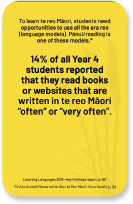
Figure 2. Example of the front of a Whakamahia card
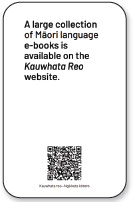
Figure 3. Example of the back of a Whakamahia card
Teachers who attended the Aronuitia te reo workshops in August 2021 told us that they found the Whakamahia set to be very useful. They commented that it would help them build up their school’s bank of reo Māori resources. The teachers particularly liked the way the QR codes allowed them quick and easy access to websites.
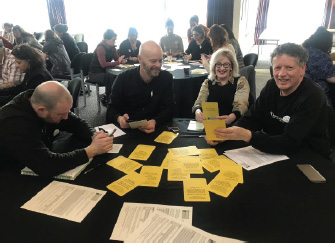
Figure 4. Teachers at our Dunedin workshop explore resources on the Whakamahia cards
Set two: Whakaarohia / Thinking about the importance of te reo Māori
My grandma is … Māori and I want to make her proud. (Year 4 student)
I’m Māori but can’t speak it very well … yet! (Year 8 student)
I think everybody should be able to walk into a shop and ask for something in Māori and get what they want. Māori is the reo [language] of Aotearoa. (Year 4 student)
These reasons for learning te reo Māori were given by students in the 2016 NMSSA study who rated the learning of te reo Māori as “very important”. While it is important for all students in Aotearoa New Zealand to learn te reo Māori, it is particularly important for ākonga Māori. To support ākonga Māori to experience success as Māori, schools need to provide an educational and linguistic environment that reflects, honours, and celebrates their language, culture, and identity. These ideas are central to the Whakaarohia set, which uses thought-provoking data—including student voice—to encourage teachers to think about the importance of providing students with opportunities to learn te reo Māori.
Within this set, the front of each card depicts an interesting finding from the 2016 NMSSA study. Take a look at the examples provided below in Figure 5. Which one catches your attention?
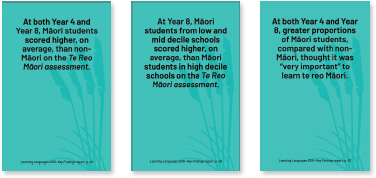
Figure 5. Examples of the fronts of three Whakaarohia cards
Like you just did, teachers using the Whakaarohia set are invited to select a card that interests them. Next, they are encouraged to use the prompts on the back of their card to think about and discuss the finding that caught their attention. These prompts, which include questions like, “What conclusions might be drawn from the information [on your card]?” and “What might the information mean for your school?”, generated rich discussion at the recent Aronuitia te reo workshops. Many teachers commented that they could see how the conversations that the cards stimulated would prompt their schools to reflect upon and strengthen their reo Māori programmes.
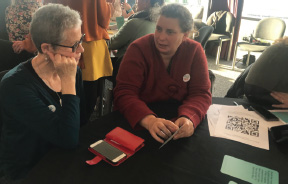
Figure 6. Two teachers at the Dunedin Aronuitia te reo workshop discuss the importance of teaching te reo Māori
Set three: Whakarauorahia / Revitalising te reo Māori
Have you and your colleagues ever stopped and thought about how your actions could support the revitalisation of te reo Māori? The Whakarauorahia set is designed to provide you with opportunities to do just this.
Did you know that the Crown has a strategy for revitalising te reo Māori? It’s called the Maihi Karauna and it contains three goals that are intended to support the revitalisation of te reo Māori (Te Puni Kōkiri et al., 2019). Recently, the Ministry of Education integrated these goals into Tau Mai te Reo, its refreshed Māori language in education strategy (Ministry of Education, 2020).
The Whakarauorahia set highlights these goals and approaches and enables schools to explore what they are doing to support them. Wondering how the Whakarauorahia set does this? Take a moment to read the “Tau Mai Approach” and “Maihi Karauna Goal” that are depicted in Figure 7.
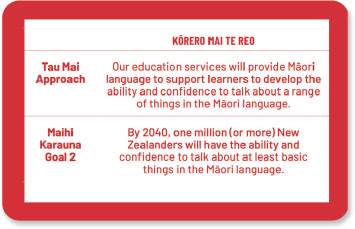
Figure 7. Whakarauorahia “Tau mai” card
After reading the card, pause and reflect on your own reo Māori ability. How well equipped are you to fulfil the expectations associated with the Tau Mai Approach that it depicts? Do you have “the ability and confidence to talk about a range of things in the Māori language”? If you answered “no” to that question, you are not alone. As you can see in the Whakarauorahia card shown in Figure 8, the teachers who participated in the 2016 NMSSA study were asked a similar question. Notably, most of them responded that it was either “not at all true” or “slightly true” that they “could hold a simple conversation in te reo Māori”.
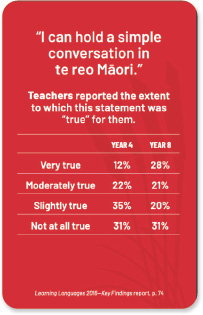
Figure 8. Whakarauorahia “I can hold a simple conversation in te reo” card
Because the Whakarauorahia set includes a series of discussion prompts, it provides teachers with opportunities to ponder findings like the one above, and to think about how well they reflect their own school’s situation. These prompts, which are designed to encourage schools to think about how well positioned they are to assist with supporting the Crown’s strategy for revitalising te reo Māori, also invite teachers and school leaders to identify ways in which they could strengthen their provision of reo Māori learning opportunities.
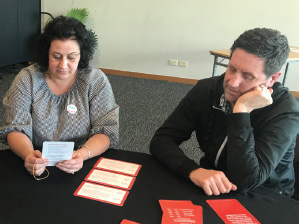
Figure 9. Teachers at an Aronuitia te reo workshop consider a card from the Whakarauorahia set
Where can you get Aronuitia te reo?
Aronuitia te reo (which can be accessed using the QR code in Figure 10), is available to download from the NMSSA website.5 Schools have the option of printing out double-sided sets or using the resource electronically. A set of instructions, which accompanies the deck of cards, includes suggestions for ways the cards can be used in schools. Teachers who attended the Aronuitia te reo workshops told us that they couldn’t wait to take the cards back to their schools and initiate discussions with their colleagues.
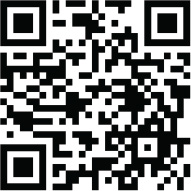
Figure 10. Aronuitia te reo QR code
Where to next?
In 2021, the Learning Languages learning area was being reassessed. As in 2016, the study includes a focus on achievement in te reo Māori. The 2021 study, however, used an online computer adaptive assessment that contained new questions, including some at level 2 of the curriculum guidelines. We are looking forward to examining both the data from this assessment and the information that the study gathers about attitudes towards, and confidence in, te reo Māori. Will any shifts have occurred in the past 5 years? We hope so. Who knows, perhaps another version of Aronuitia te reo will need to be developed—watch this space.
Building on from the NMSSA’s Te Reo Māori assessment, NZCER developed its own online adaptive tool to assess students in Year 4 to Year 9 who are learning te reo Māori in English-medium schools. The questions in NZCER’s Te Reo Māori assessment toolTe Reo Māori assessment tool cover levels 1 to 3 of Te Aho Arataki Marau mō te Ako i Te Reo Māori—Kura Auraki: Curriculum Guidelines for Teaching and Learning Te Reo Māori in English-Medium Schools—Years 1–13. This online tool uses an adaptive programme that dynamically selects questions based on how well the student has been able to answer previous questions in the assessment. This ensures the results more accurately reflect the student’s ability, as well as providing a positive experience for the student. As provided for in the NMSSA assessment, there is an audio option for every question, allowing students to hear as well as read the question being asked. Schools can use the data from this assessment to measure and track the progress of their students and discuss the implications for their school.

Text box 2. Are you interested in assessing your students’ te reo Māori knowledge?
Notes
1Based on feedback from participants who attended Aronuitia te reo workshops in August 2021.
2More information about NMSSA can be found at https://nmssa.otago.ac.nz/
3In 2018, the NMSSA project team began writing Insights reports designed to support teachers to improve teaching and learning by highlighting areas of interest from the study. The first two reports drew on the findings from the 2017 learning areas: Science, and Health and Physical Education. Since then, six more reports across three other learning areas have been produced. These reports can all be found on the NMSSA website.
4Cameras on most smart phones also act as QR code scanners.
5https://nmssa.otago.ac.nz/
References
Bright, N., Smaill, E., Overbye, S., & Edge, K. (2021). He reo ka tipu i ngā kura / Growing te reo Māori in schools: Literature review. NZCER. https://www.nzcer.org.nz/system/files/He_Reo_Ka-Tipu.pdf
Education Review Office. (2020). Te tāmata huaroa: Te reo Māori in English-medium schooling. Author. https://www.ero.govt.nz/assets/Uploads/ERO-Tamata-Hauroa-Report-FINAL.pdf
Ministry of Education. (2007). The New Zealand curriculum. Learning Media.
Ministry of Education. (2009). Te aho arataki marau mō te ako i te reo Māori—kura auraki: Curriculum guidelines for teaching and learning te reo Māori in English-medium schools: Years 1–13. Learning Media.
Ministry of Education. (2020). Tau mai te reo. Author. https://education.govt.nz/assets/Uploads/Tau-Mai-Te-Reo-FINAL.pdf
Murphy, H., Reid, D., Patrick, A., Gray, A., & Bradnam, L. (2019). Whakanuia te reo kia ora: Evaluation of te reo Māori in English-medium compulsory education. Te Taura Whiri i te Reo Māori. https://www.tetaurawhiri.govt.nz/assets/Research/f0dc677bf5/Whakanuia-Te-Reo-Report.pdf
NMSSA. (2016a). Learning languages 2016—key findings (Report No. 12). Educational Assessment Research Unit, University of Otago, and NZCER. https://nmssa.otago.ac.nz/reports/2016/2016%2012_LLang%20AccessiblePDF.pdf
NMSSA. (2016b). Learning languages [Summary report]. Educational Assessment Research Unit, University of Otago, and NZCER. https://nmssa.otago.ac.nz/reports/2016/2016%20Languages%20Outsert.pdf
Te Puni Kōkiri, Te Taura Whiri i te Reo Māori, Te Māngai Pāho, Māori Television, Te Tari Taiwhenua, Te Tāhuhu o Te Mātauranga, & Manatū Taonga. (2019). Maihi karauna: The Crown’s strategy for Māori language revitalisation 2019–2023. Author.